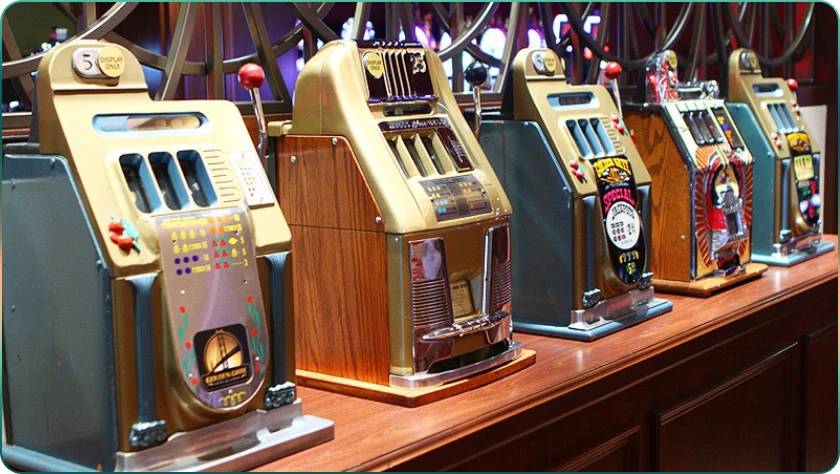Timeline of Slot Machines - From One-Armed Bandits to Digital Wonders

Over the last few years, the gambling industry has witnessed a considerable shift in many different verticals. One that has evolved dramatically over the years is products, specifically slots and their changes. Many of us can recall the charm of the old-style slot machines, such as the iconic one-armed bandits that graced the floors of brick-and-mortar casinos, a nostalgic reminder of the humble beginnings of our beloved slots.
However, it can be said with certainty that slot machines have enchanted many casino enthusiasts for nearly a century, transforming from simple mechanical devices into the sophisticated digital games we know today. Over the last few decades, slot machines have evolved remarkably, with significant technological advancements changing the gambling landscape.
As a result, the industry has attracted new audiences, expanded its reach, and evolved into an entertainment juggernaut. Understanding this transformation reveals how far slots have come and how they might continue to grow.

The Origins of Slot Machines
The first slot machines, created in the late 19th century, were mechanical devices with spinning reels. These early machines operated using a lever players pulled to set the reels in motion. The outcome was determined by where the reels stopped, and winnings were paid out according to the symbols lined up. These machines were simple in design, typically featuring three reels and a limited number of symbols, often including iconic images like bells, horseshoes, and fruit.
The mechanical reels of these early machines offered a tangible sense of interaction. Players could see the gears turning, hear the clicks, and feel the resistance of the lever. As a result, these machines provided a highly engaging experience despite their basic functionality. This physical engagement became one of the primary reasons slots gained such popularity, becoming a staple of casinos and amusement parlours worldwide.
While the design was rudimentary, these early machines laid the groundwork for a global gambling phenomenon. However, the limitations of mechanical systems restricted game options, with only a few possible outcomes. Nevertheless, the demand for more varied and engaging gameplay would eventually lead to substantial innovations.
A New Era of Casino Innovation
By the mid-20th century, the next significant evolution occurred with the development of electromechanical slot machines. These machines introduced electrical components while maintaining the mechanical reels, creating more complex and varied gameplay. As such, electromechanical slots could offer more betting options and larger payouts than their fully mechanical predecessors.
One of the key innovations of this period was Bally Technologies' introduction of the "Money Honey" machine in 1963. It was the first fully electromechanical slot, where players no longer needed to pull a lever to spin the reels but instead could push a button. As a result, this marked a shift in how players interacted with slots, increasing the pace of play and making the machines more user-friendly. The faster gameplay encouraged more frequent spins, ultimately contributing to the substantial profitability of slot machines for casinos.
Electromechanical slots also introduced the possibility of higher jackpots. With electrical components driving the reels, more symbols could be added, increasing the number of potential winning combinations. This increased variety and made the games more appealing, drawing in more players.
The 1990s Online Slot Boom
The digital revolution of the 1990s propelled the most significant leap in the evolution of slot machines. As technology advanced, casinos transitioned from electromechanical machines to fully digital, computer-based systems. This shift not only transformed how slots worked but also opened up a world of possibilities for the future of slot gaming.
The introduction of Random Number Generators (RNGs) was one of the most significant technological advancements during this period. With RNGs, the outcomes of slot spins were determined by a complex algorithm, ensuring that results were entirely random and not dependent on physical mechanisms. This allowed for the creation of games with multiple paylines, various themes, and interactive bonus features, providing players with an immersive and entertaining experience.
RNGs are a crucial component in online slots, ensuring fairness and unpredictability in gameplay. An RNG is a sophisticated algorithm that generates a sequence of numbers at lightning speed, each corresponding to a specific outcome on the slot's reels. These numbers are produced continuously, even when the game isn’t being played. When a player spins the reels, the RNG selects a number from the sequence, determining the symbols that appear on the screen. As a result, every spin is independent and random, providing a fair and unbiased outcome for each player.
Online slots also enabled the development of progressive jackpots, a major draw for players. Unlike traditional slots where the jackpot was fixed, progressive jackpots accumulated over time as players wagered, resulting in substantial payouts that could reach the millions. This innovation, driven by digital systems, made slots even more appealing to a broad audience.
Furthermore, online slots opened up endless possibilities thematically. Game developers, who have played a crucial role in the evolution of slot machines, could now incorporate advanced graphics, sound effects, and animations to create games based on popular culture, mythology, movies, and more. As a result, slots became not just games of chance but also entertainment experiences, appealing to players on multiple levels.
From Casino Floors to App Stores
The advent of the internet marked a new era for slot machines. In the early 2000s, online gambling sites began to emerge, fundamentally changing how people accessed and played casino games. The rise of online slots not only expanded the audience for slot games but also set the stage for the exciting future of slot gaming.
Online slots offered more variety than land-based counterparts, with developers constantly creating new themes, features, and gameplay mechanics. Players could then choose from various options, including classic three-reel games and advanced five-reel video slots, with mini-games, multipliers, and free spin bonuses. The convenience of playing online and the sheer variety of games helped drive the popularity of slots even further.
Mobile gaming became a significant industry force as smartphones became more widespread in the 2010s. Developers quickly adapted to this trend, creating mobile-optimised slots that could be played on smaller screens without compromising quality. Mobile slots allowed players to spin the reels on the go, making gambling more accessible. This increased accessibility has substantially boosted player engagement and, as such, expanded the global reach of slot gaming.

The Future of Slot Machines
As technology advances, slot machines' future looks poised for further innovation. One of the most anticipated developments is integrating virtual reality (VR) and augmented reality (AR) into slot games. However, VR, AR and mobile gambling innovations also bring potential challenges, such as the need for high-quality hardware and the risk of increased addiction due to the immersive nature of these experiences. Similarly, while blockchain technology and cryptocurrencies are likely to play a role in the advancement of slots, they also bring regulatory and security challenges that the industry will need to navigate.
Blockchain technology and cryptocurrencies are also likely to play a role in the evolution of slots. Some online casinos already accept cryptocurrencies like Bitcoin and blockchain technology could be used to create transparent, provably fair games where players can verify the integrity of each spin. As a result, trust in the fairness of slots could increase, especially in markets where regulation is less stringent.
In addition, the trend of social casinos is expected to continue growing. Many modern slots already incorporate social elements, such as leaderboards, achievements, and in-game chat features. Future slot machines could take this further, offering multiplayer experiences where players can compete or collaborate in real time to unlock bonuses or achieve shared goals.
Integrating skill-based elements into slot games is another trend that may shape the future of slots. Traditional slots are entirely luck-based, but newer games are beginning to incorporate skill-based features, where a player’s decisions can impact the outcome of a bonus round or the amount they win. This trend could attract younger players who prefer more interactive and engaging gaming experiences.
Finally, regulation and market dynamics will likely shape the future of slots. As governments impose stricter regulations on gambling, particularly regarding responsible gaming and player protection, developers may need to adapt their games to meet these requirements. At the same time, expanding markets in the US and Asia could lead to developing region-specific games that cater to local tastes and preferences.
How Slots Took Over the Casino Floor
Slots have always been a crucial component of casino gaming, but their role in the industry has changed substantially over the years. Initially viewed as simple, low-stakes games for casual gamblers, slots have become the primary revenue generator for online and land-based casinos. The continuous evolution of technology has allowed slots to stay relevant and maintain their popularity among new generations of players.
The rise of digital slots has led to more competition in the market, with game developers constantly striving to create the next big hit. As a result, the quality of slot games has improved significantly, with advancements in graphics, gameplay, and interactivity driving the industry forward. Slots are no longer just about spinning reels; they are immersive entertainment experiences that combine the thrill of gambling with the excitement of storytelling and innovation.
Looking forward, the slot machine industry shows no signs of slowing down. With technological advancements, shifting market dynamics, and evolving player preferences, slots will remain a vital part of the gambling world for decades.





Review this Blog
Leave a Comment
User Comments
comments for Timeline of Slot Machines - From One-Armed Bandits to Digital Wonders